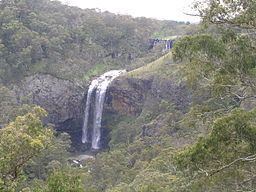- elevation 304 m (997 ft) | - elevation 1,410 m (4,626 ft) | |
 | ||
- right Pantons Creek, Marengo Creek - location within Guy Fawkes River National Park | ||
Dalmorton camp ground guy fawkes river conservation area south west of grafton nsw
Guy Fawkes River, a perennial stream that is part of the Clarence River catchment, is located in the New England and Northern Tablelands districts of New South Wales, Australia.
Contents
- Dalmorton camp ground guy fawkes river conservation area south west of grafton nsw
- Map of Guy Fawkes River New South Wales Australia
- Course and features
- Name
- References
Map of Guy Fawkes River, New South Wales, Australia
Course and features
Guy Fawkes River rises below Majors Point, on the northern slopes of the Snowy Range, an eastern spur of the Great Dividing Range, east of the village of Ebor. The river spills over the 115 metres (377 ft) columned basalt rock Ebor Falls, and enters a deep valley, joined by four tributaries, including Aberfoyle River, flowing generally northward and eventually forming its confluence with the Sara River to form the Boyd River. The river descends 1,110 metres (3,640 ft) over its 101 kilometres (63 mi) course; and passes below Round Mountain, the highest peak of the Northern Tablelands.
The course of the river generally runs from the south to north along the valley of the Demon Fault Line, within the Guy Fawkes River National Park. Adjoining the national park are the Guy Fawkes River Nature Reserve and Guy Fawkes River State Conservation Area.
The Bicentennial National Trail runs along the western side of Guy Fawkes River on what is a travelling stock route.
The largest of the Grevillea genus, Southern Silky Oak, or Grevillea robusta, is distributed in the Guy Fawkes River area, which is the southern limit of its natural environment. It has attractive orange-yellow flowers and may reach up to 35 metres (115 ft) with a trunk diameter in excess of 1 metre (3 ft 3 in).
Name
The river is named after Guy Fawkes. Major Edward Parke named the Guy Fawkes River after camping nearby on Guy Fawkes Day, 5 November 1845.
